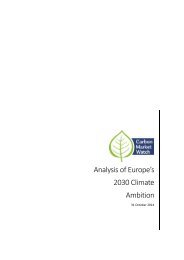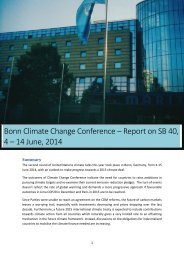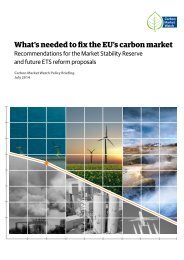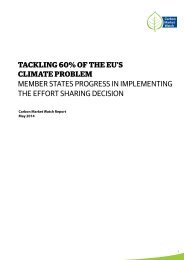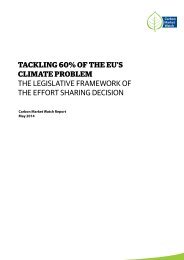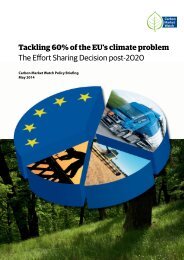What’s needed to fix the EU’s carbon market
You also want an ePaper? Increase the reach of your titles
YUMPU automatically turns print PDFs into web optimized ePapers that Google loves.
currently constitute more than half<br />
of <strong>the</strong> more than two billion excess<br />
allowances in <strong>the</strong> <strong>carbon</strong> <strong>market</strong> (see<br />
also figure 2).<br />
3. <strong>EU’s</strong> emissions experienced a decrease<br />
as <strong>the</strong> economic crisis had an impact on<br />
<strong>the</strong> industrial production and electricity<br />
consumption. However, it is clear that<br />
even if economic growth returns <strong>to</strong> prerecession<br />
levels, emissions are unlikely<br />
<strong>to</strong> climb back <strong>to</strong> high levels. From 1990<br />
<strong>to</strong> 2011, <strong>EU’s</strong> economy grew 45% while<br />
emissions decreased by 18.3%. 7<br />
Figure 2: The build-up of surplus in<br />
EU ETS up <strong>to</strong> 2020 5 Figure 3: The impact of offsets on <strong>the</strong> post-2020 domestic reduction effort 11<br />
CARBON OFFSETS<br />
Under <strong>the</strong> EU ETS, companies can purchase up <strong>to</strong> 50% of <strong>the</strong>ir<br />
emissions reduction obligations through <strong>carbon</strong> credits from<br />
offsetting projects in developing countries. The overall limit is set at<br />
1.6 billion offset credits for phase II and III (2008-2020) 9 . The price for<br />
<strong>carbon</strong> offsets is low: <strong>the</strong>y are currently selling at €0.10 (see Figure 1).<br />
European companies have rushed <strong>to</strong> exploit this option, which<br />
allows <strong>the</strong>m <strong>to</strong> meet <strong>the</strong>ir current and future reductions efforts<br />
more cheaply than by purchasing allowances under <strong>the</strong> EU ETS.<br />
Even though companies are expected <strong>to</strong> overshoot <strong>the</strong>ir collective<br />
2020 target without needing <strong>to</strong> buy any credits, companies have<br />
incentives <strong>to</strong> purchase international offset credits because this frees<br />
up EU <strong>carbon</strong> allowances that <strong>the</strong>y can bank <strong>to</strong> meet <strong>the</strong>ir post-2020<br />
reduction obligations or sell in<strong>to</strong> <strong>the</strong> <strong>market</strong> at a profit.<br />
The domestic nature of <strong>EU’s</strong> 2030 climate target is only guaranteed if<br />
<strong>the</strong> following conditions are met:<br />
• International offsets cannot be used after 2020 as it delays<br />
domestic abatement and crowds out European investments in<br />
clean technologies.<br />
• At least 1.6 billion allowances are cancelled from <strong>the</strong> system<br />
(which is equivalent <strong>to</strong> <strong>the</strong> accumulated amount of international<br />
offsets by 2020).<br />
• The EU ETS directive includes safeguards that ensure linking<br />
with o<strong>the</strong>r emission trading systems does not compromise <strong>EU’s</strong><br />
domestic climate target.<br />
Recently, <strong>the</strong> Commission and <strong>the</strong> Parliament have proposed that<br />
no international offsets can be<br />
used <strong>to</strong> meet <strong>the</strong> 40% domestic<br />
greenhouse gas reduction target<br />
for <strong>the</strong> year 2030. However, this<br />
welcome step <strong>to</strong>wards domestic<br />
climate action in Europe is still<br />
threatened by <strong>the</strong> current banking<br />
rules that allow <strong>the</strong> carry-over<br />
of offset credits that have been<br />
converted in<strong>to</strong> EU ETS allowances.<br />
This means that <strong>the</strong> 1.6 billion<br />
international offsets that will have<br />
accumulated in <strong>the</strong> system by<br />
2020 can be used <strong>to</strong>wards <strong>the</strong> 2030<br />
reduction target. The future target<br />
will hence fall short of 1.6 billion<br />
<strong>to</strong>nnes of domestic action, which<br />
implies that <strong>EU’s</strong> 40% domestic<br />
climate target for <strong>the</strong> year 2030<br />
could in reality only represent 34%<br />
domestic emission reductions 10 ,<br />
see also figure 3.<br />
4





